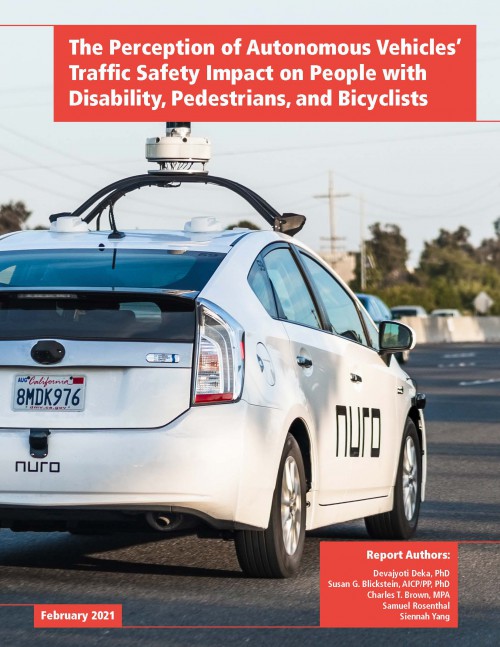Autonomous vehicles (AVs), commonly referred to as self-driving cars or driverless cars, have seen tremendous investment and technological advancement over the past decade, and their deployment will almost certainly result in radical changes to the built environment, transportation infrastructure investments, and the ways we travel. As these technologies continue to be developed, planners, policymakers, and the general public have become increasingly aware of AVs and have begun to think about their potential impacts. There is hope that AVs could bring about promising environmental and safety benefits, but there remain valid concerns regarding AVs’ effect on road design and congestion, and some fear that AVs may, in fact, have a negative impact on road safety¬, particularly for vulnerable road users. These concerns are significant because the ability of AVs to deliver any benefits will depend not only on how the technology is integrated and employed, but also on how all roadway users perceive and respond to sharing roads with AVs and on how AVs’ impacts on people and communities play out.
In an effort to better understand the public’s comprehension of and concerns regarding AVs–and ultimately plan for safe and effective AV integration–this report examines the perceptions of AVs’ safety impacts on vulnerable road users, specifically pedestrians, bicyclists, and those with disability. Part I of the report includes a literature review that covers existing research regarding pedestrians’ and bicyclists’ perceptions of AVs and helps to identify where further research is needed. The literature review informs the design of the survey and focus groups that follow.
Part II of the report discusses findings from a statewide survey of 1,001 New Jersey adults about the perception of the potential impact of autonomous vehicles on pedestrians, bicyclists, and people with disability. Statistical modeling of survey results shows that the two variables that consistently affect the perception of AVs’ safety impacts are familiarity and gender, and that people with ambulatory disability are highly concerned about a negative safety impact of autonomous vehicles on people with disability.
Part III of the report discusses findings from three focus groups conducted to provide supplemental qualitative information regarding how pedestrians, bicyclists, and people with disability presently view autonomous vehicles and their potential impacts on safety for those three groups. Focus group findings were consistent with survey results in that those with disability expressed heightened concern over autonomous vehicles’ safety impacts, both generally and for people with disability in particular. At the same time, focus group participants were both less familiar with AVs and less optimistic about AVs’ ability to improve safety than survey respondents. While many participants believed that AVs could reduce the frequency and severity of vehicle-to-vehicle collisions, they were more skeptical about their ability to improve safety for more vulnerable road users.
The insights gained through this research provide a deeper understanding of the public’s perceptions and concerns regarding AVs’ safety impacts on vulnerable road users and should be considered by planners and policymakers when determining safe and effective methods of AV integration into existing transportation systems. This research is also particularly relevant to New Jersey, due in part to the state’s high number of crashes involving pedestrians and bicyclists. Between 2014 and 2018, there were 1,034 serious injuries and 934 fatalities for bicyclists and pedestrians in the state, and the FHWA has identified New Jersey as a bicyclist and pedestrian focus state (NJDOT, 2020). A better understanding of AVs’ perceived safety impacts on vulnerable road users will be crucial to reducing fatalities and serious injuries for these groups. Furthermore, New Jersey’s ubiquitous and complicated highway system, range of land uses, and varied community types (urban, suburban, and rural) will pose unique challenges for the deployment of autonomous vehicles. As a result, this research is especially pertinent to the state as it looks toward the future of AV integration.
Read full report: The Perception of Autonomous Vehicles’ Traffic Safety Impact on People with Disability, Pedestrians, and Bicyclists
New Jersey Bicycle and Pedestrian Resource Center. (2021). The Perception of Autonomous Vehicles’ Traffic Safety Impact on People with Disability, Pedestrians, and Bicyclists. Retrieved from https://njbikeped.org/portfolio/perception-autonomous-vehicles-traffic-safety-impact/`

